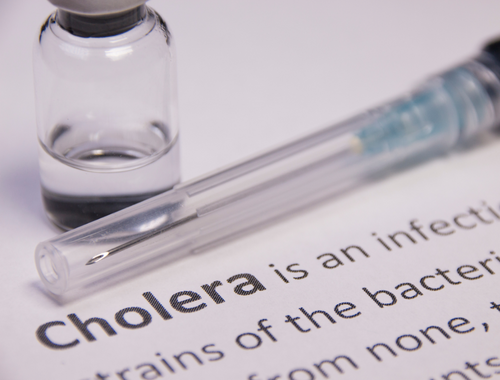Difference Between Cholera and Typhoid
Cholera is an intestinal illness that is a result of infection by vibrio bacteria. Typhoid is an infection of the intestines that is a result of infection by Salmonella bacteria.

What is Cholera?
Definition:
Cholera is an infection of the small intestine that is a result of vibrio bacteria.
Causative pathogen:
The pathogen that causes cholera is a gram-negative bacterium called Vibrio cholerae.
Diagnosis:
Diagnosis can be confirmed by growing bacteria from stool cultures. PCR tests looking for the genetic material of the bacteria can also lead to a positive diagnosis of cholera. In less developed areas that lack PCR testing, there are dipstick tests that can also be used to test for cholera.
Symptoms:
Diarrhea and vomiting are the main symptoms. The diarrhea is often watery and called rice-water diarrhea because it often contains a lot of white material. In severe cases, dehydration can be very rapid.
Complications:
The most common complication of cholera is extreme dehydration. This loss of water and electrolytes can cause muscle cramps, can affect the heart adversely. Dehydration can also cause other organs like the kidney to fail, which can rapidly lead to death. A further complication is that low blood sugar (hypoglycemia) can set in, which can result in seizures, coma, and death.
Treatment:
Doxycycline and some other antibiotics such as, azithromycin and ciprofloxacin are administered to treat cholera. Rehydration therapy is also essential because of the dehydration that comes with the illness.

What is Typhoid?
Definition:
Typhoid is a digestive illness in which the intestines are afflicted with Salmonella typhi.
Causative pathogen:
The cause of typhoid is S. typhi bacteria invading the small and large intestines.
Diagnosis:
Diagnosis of typhoid can be achieved with various tests including blood tests, and culturing samples from urine and stools to see if the S. typhi bacteria are present.
Symptoms:
The signs of typhoid include pain in the abdomen, constipation, and diarrhea. A high fever occurs that lasts for 7 days. A rash on the skin of the belly and chest also occurs with infection.
Complications:
Intestinal perforation is a common complication of typhoid. This may quickly result in spreading infection and death.
Treatment:
Typhoid is routinely treated by prescribing the antibiotics, more specifically ceftriaxone or ciprofloxacin.
Difference between Cholera and Typhoid?
Definition
Cholera is a small bowel infection caused by vibrio bacteria. Typhoid is an intestinal infection caused by salmonella.
Causative organism
The pathogen causing cholera is Vibrio cholerae. The pathogen responsible for typhoid is Salmonella typhi.
Incubation period
Cholera incubation is 2 hours to about a week. Typhoid incubation is a week to a month.
Mode of transmission
Cholera is transmitted by people ingesting water and food that have the bacteria in it. Typhoid is transmitted from contaminated food (including from fly contamination) to people.
Digestive system symptoms
Cholera causes vomiting, nausea, sore stomach, and profuse watery rice-stool diarrhea. Typhoid causes belly pain, diarrhea, and constipation.
Type of fever
Cholera does not produce a fever in patients. Typhoid causes a fever of about 103°F.
Complications
Complications of cholera include dehydration leading to electrolyte loss, muscle cramps, kidney failure, and death. The complications of typhoid include intestinal perforation and death.
Mortality rate
The mortality rate of cholera is anywhere from 25 to 50%. The mortality rate of typhoid is from 12 to 30%.
Table comparing Cholera and Typhoid

Summary of Cholera Vs. Typhoid
- Cholera and typhoid are both bacterial infections of the gastrointestinal system.
- Cholera affects the small intestine and can result in rapid dehydration.
- Typhoid impacts both the large and small intestine and can lead to intestinal perforation.
- Both typhoid and cholera are uncommon today, but are still dangerous infections.
FAQ
Are cholera and typhoid the same?
No, cholera and typhoid are two separate infections caused by different pathogenic bacteria.
What is common between cholera and typhoid?
Cholera and typhoid are both bacterial infections of the digestive tract.
What is the difference between cholera and salmonella?
Cholera causes fluid to be produced in the intestines as does salmonella, but salmonella also causes an inflammatory response while cholera doesn’t, and different bacteria are involved.
What is the difference between typhoid and typhus?
While both typhoid and typhus are a result of bacterial infection, typhoid is due to a different type of bacteria, and it is spread by contaminated food. Typhus, on the other hand, is spread to people by the bite of a flea.
What is typhoid called today?
Typhoid is also known as enteric fever today.
Does cholera still exist?
Yes, cholera still occurs today, but most often in areas of the world where there is poverty and improper sanitation. Natural disasters can also make getting cholera more likely.
What’s the cause of cholera?
Cholera is caused by Vibrio cholerae bacteria.
When was a cure for typhoid found?
A vaccine was developed against typhoid in the late 1800s. In the 1940s, there was the development of antibiotics to treat typhoid.
Do people survive typhus?
If treated, people can survive typhus. However, if untreated the mortality rate can average 40%.
- Difference Between Rumination and Regurgitation - June 13, 2024
- Difference Between Pyelectasis and Hydronephrosis - June 4, 2024
- Difference Between Cellulitis and Erysipelas - June 1, 2024
Search DifferenceBetween.net :
Leave a Response
References :
[0]Bush, Larry M. and Maria T. Vazquez-Pertejo. “Cholera”. Merckmanuals. Merck & Co., 2022, https://www.msdmanuals.com/professional/infectious-diseases/gram-negative-bacilli/cholera
[1]Bush, Larry M. and Maria T. Vazquez-Pertejo. “Typhoid fever”. Merckmanuals. Merck & Co., 2022, https://www.msdmanuals.com/professional/infectious-diseases/gram-negative-bacilli/typhoid-fever
[2]Chowdhury, Fahima, et al. "Diagnosis, Management, and Future Control of Cholera." Clinical Microbiology Reviews 35.3 (2022): e00211-21.
